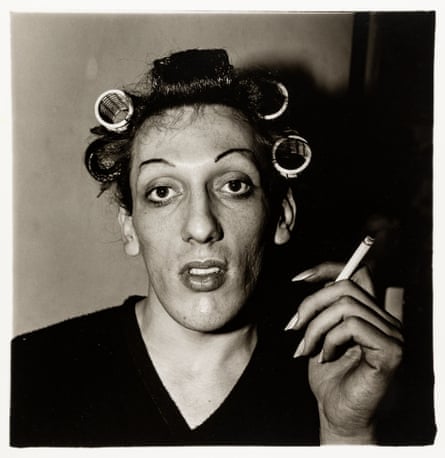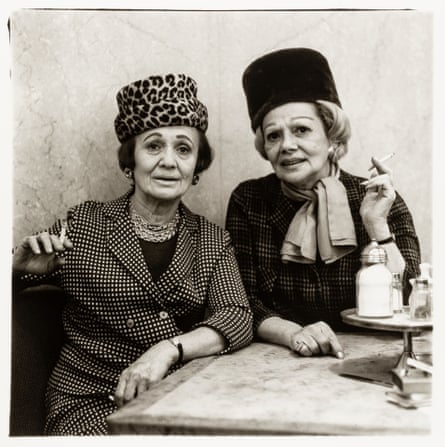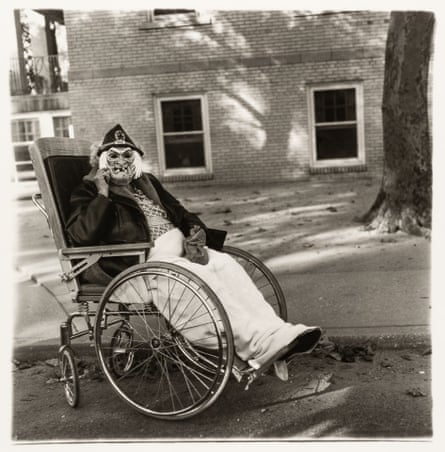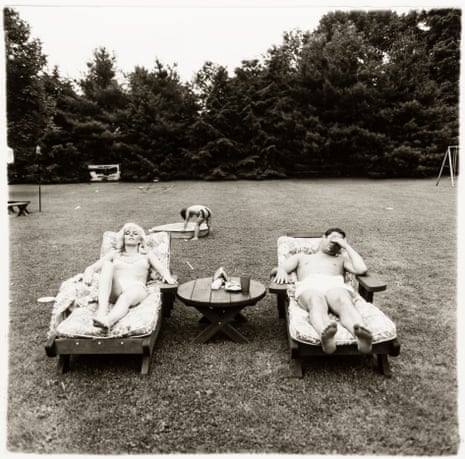Diane Arbus was drawn to people who reminded her of important figures in her life, such as her flamboyant maternal grandmother or her lover Marvin Israel. More generally, she was fascinated to the point of obsession by the discrepancy between who we are and how we want to be seen – what she called “the gap between intention and effect”. Her list of favourite subjects includes female impersonators, lobby murals of sylvan scenes and dioramas of murderers. As the scrutiny of her camera disclosed, they were not quite what they first appeared to be.
Diane Arbus: Constellation, an exhibition at the Luma Foundation in Arles, France, is the largest display of Arbus prints ever mounted. In 2011, Maja Hoffmann, the Swiss pharmaceutical heiress who founded Luma, purchased all 454 printer’s proofs made by Neil Selkirk, the sole person authorised to print Arbus negatives after her suicide in 1971. At the suggestion of Luma photography curator Matthieu Humery, Hoffman is displaying all the photos for the first time, to mark the centenary of Arbus’s birth.

On the ground floor of the shimmering Luma steel tower, which was designed by architect Frank Gehry, Humery has hung the photographs on metal scaffolds, placing a mirrored wall at the back so the room appears to extend indefinitely. “I wanted to break the idea of your being in a museum,” he explains. “If you walk outside, you don’t see a wall. And when you walk in here, you don’t know where it ends.” There is no prescribed path: you roam, as Arbus wandered through New York. In time, you start to see things as she did, a random arrangement in which each image carries a jolt of both surprise and recognition.
In a subtle gesture, the metal supports at the centre of the room turn at a slight angle to the grid, demarcating where Humery hung the pictures that Arbus selected for her Box of Ten Photographs, which in her last year she peddled with very limited success. (The price was $1,000. A print she made of the most famous photo in the collection – Identical Twins, Roselle, NJ 1966 – sold at auction in 2018 for $732,500.)
Although fans may begrudge the omission of their favourite pictures (for me, Child With a Toy Hand Grenade in Central Park, NYC 1962, is regrettably absent), Arbus was an excellent judge of her own work. The chosen 10 display her range: among them, those New Jersey twins who – manifesting completely different demeanours in identical bodies – seem to reveal within one image the alternative sides of a personality; the demonstrator with a tranquil air of innocence that belies his belligerent pro-Vietnam war buttons; the middle-aged nudist couple at home, where a bare-breasted “girlie” picture decorates their wall and naked portraits of the pair stand atop the TV; the parents of the Jewish giant looking at their son with awe and dismay as his head grazes their apartment ceiling; the beautiful blonde wife and exasperated husband lying on recliners on their suburban lawn, as their little son bends over an inflatable pool in the background; and a sterile living room in a Long Island tract home decorated with cheerless festivity for Christmas.

For those familiar with her output, Constellation offers an unprecedented opportunity to see rare images, some never before published. They do not change one’s estimation of the artist; none of the unknown pictures rival her many famous ones, even if they would rank as high points for another photographer.
But it is nonetheless fascinating to see how many pictures she took, in addition to those we have long admired, of circus performers backstage, female impersonators in their dressing rooms, nudist families, impoverished people living in shacks in Beaufort, South Carolina, and solitary women whom she might find on the street, or in waiting rooms or at black-tie balls.
Thought-provoking, too, are the alternate takes of well-known images. Girl in a Shiny Dress, NYC 1967, is a celebrated portrait of a latter-day flapper. She looks a little inebriated as she smiles for the camera, the left spaghetti strap of her slinky dress having slipped off her shoulder. There is a head shot of the same woman, Girl with Painted Eyelashes, NYC 1967, that, because the strap is still in place, seems to have been taken earlier. It is far less effective. Seeing them in the same room reminds us of the difference between a great photograph and one that is merely very good.
after newsletter promotion

It is regrettable that the guide to the exhibition doesn’t distinguish between the pictures Arbus chose to print and those only printed later by Selkirk. A photographer not only exposes and processes the film – she also selects and prints what she deems worthy of exhibition. Sometimes, as was the case with Arbus’s teacher, Lisette Model, the photographer also crops the image, but Arbus was fanatical about printing the full frame, typically including the edge of the film in the print.
When an extensive selection of Arbus’s photographs of people with developmental disabilities was published as a book in 1995, some critics objected on the grounds that, as it was a project on which Arbus was working when she died, many of the photographs included were ones she never chose to print herself. Personally, I am happy to see any picture she took, but I would appreciate knowing whether they carry her imprimatur.

The main impression left by this extraordinary exhibition, which provides a full view of Arbus’s manifold achievement, is how much great work she produced in her 15-year career and how fresh it continues to feel more than half a century after her death. Because she regarded her subjects with a trademark blend of empathy and ridicule, Arbus remains a controversial and unsettling artist.
Staring at a person with dwarfism, half-naked in bed with a jaunty hat on his head and a post-coital, glazed look on his face, what are we to think? What was Arbus thinking? More than any other photographer, she leaves us guessing, because she herself was riven by contradictions.
The debate between critics who extol Arbus’s love for her subjects and those who denounce her for mocking them completely misses the point. With Arbus, it is never a question of either/or. There can be little doubt she found humanity ridiculous as well as sympathetic. Like the author Franz Kafka, she would giggle as she displayed her creations, fully aware of both the courage required and the absurdity imposed by human existence.
Arthur Lubow is the author of Diane Arbus: Portrait of a Photographer
Diane Arbus: Constellations is at Luma Arles until 30 April 2024

Comments (…)
Sign in or create your Guardian account to join the discussion